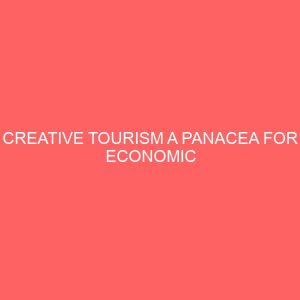Description
ABSTRACT
Using Marketing in Tourism creates a clear view about the real state of developing Tourisms offers and its effects, dealing with marketing elements through Promotion and Distribution of Tourisms product. The purpose of using Marketing concept in Tourisms activity is to stimulate and to help promote tourist destination. Without successful functioning of Marketing in todays surrounds and worlds global business, Tourism and the other business branches, would be convicted in failure. Although, the activity of Tourism is of a seasonal character, Marketing concept with its advantage, firstly recognized by its Tourism product, then by its opportunities for a better use of Tourism capacity. With this given framework of research, as intensive work of economy activity in frame of Tourisms economy it has distinctly economy function in countries in which are developing the Tourisms movements.
CHAPTER ONE
1.0 INTRODUCTION
Marketing is an organizational function and a set of processes for creating, communicating, and delivering value to customers and for managing customer relationships in ways that benefit the organization and its stakeholders American Marketing Association 2004.
Even though some marketing practices are as old as human trade, the marketing concept has its roots in the United States of America in the late 19th century. The social climate at the time was inspired by a strong economic upswing. Salesmen were perceived of as a proud symbol of American commerce, Converse 1959, p. 2 and business barons like Morgan, Rockefeller, and Carnegie became the idols of an adventurous and upcoming market society pp. 1920. The washing machine, the refrigerator, and affordable motorized vehicles were introduced to the markets at this time, and, by using their dollars, the people democratically decided voted on product success or failure Hotchkiss 1938. Around the same time, American farmers found themselves in the unfortunate situation of being taken advantage of by institutionalized distributors of agricultural products. As a consequence, farmers founded agricultural cooperatives that organized the distribution of goods across the American continent without the support of avaricious intermediaries. The problems of market distribution that emerged with this progressive movement were both the roots and the main focus of marketing research Bubik 1996; Butler 1917; Carver 1917; Powell 1910; Shaw 1912. In this context, Powell 1910 was the first to use the term marketing in a scientific publication in the Quarterly Journal of Economics, where he describes the distribution of Californian fresh fruit to Eastern markets.
The years following World War I, up until Black Friday, Oct. 10th, 1929, were often characterized as the Golden Twenties Bubik 1996 but also the Merchandizing Era, Hotchkiss 1938, p. 241 and the chain store decade Converse 1959, p. 37. Marketing was on the rise, and marketers were concerned with the complexities of national advertising campaigns, market research, sales management, and strategic product policy, whereas marketing researchers were developing and integrating the fundamental knowledge of marketing. In the decade from 1920 to 1930, 29 general marketing monographs were published that summarized the methodical body of marketing knowledge Bartels 1988, p.358f.. In the 1930s, leading institutions like the American Marketing Association 1937 and the Journal of Marketing 1936 were founded to organize and support the emerging marketing research and practice. By 1945, scholarly research had addressed many marketing issues that became trends at the close of the 20th century. Shaw 1912, for instance, called for customer orientation in 1912, which then became a dominant topic in the 1960s, and Clark 1924 required the elimination of middlemen in 1924, which became en vogue again with the rise of digital disintermediation in the Internet economy. In addition, consumer resistance was of interest in the 1930s Fisk 1967, as was the social responsibility of marketing action in the late 1960s Fisk 1967; Lazer 1969. Both are on the rise and are of interest to contemporary marketing researchers, yet motivated by very different socio and technocultural research agendas Holt 2002; Klein 1999; Kozinets 2002; Kozinets and Handelman 2004.
After World War II, marketing scholars began to develop powerful marketing management concepts as well as market and behavioral theories that are still used today Bubik 1996; Fullerton 1988. Wellknown examples are McCarthys 4 ps 1964, Bordens marketing mix 1965, Fishbeins measurement of mental attitudes 1967, the Boston Consulting Groups portfolio matrix ca. 1970, Porters 5forces 1979 and the SWOT analysis ca. 1978.2 Kotler and Levy 1969a; 1969b; 1971 initiated an influential discussion about the focus of marketing with their publication Broadening the Concept of Marketing Kotler and Levy 1969a in the late 1960s. They suggested using marketing principles not only in a business context but also for nonprofit organizations, a suggestion that was controversially perceived Luck 1969. Around the same time, the first editions of Marketing Management Kotler 1967, 2003b and Marketing Nieschlag, Dichtl and Hrschgen 2002 19th Ed.; Nieschlag and Hrschgen 1969 1st Ed. were published. These monographs summarize, distribute, and continuously update the accepted body of marketing knowledge until today.
The quest for a general theory of marketing was launched at the winter conference of the AMA in Pittsburgh in 1946. The goal of developing such a theory was to outline a framework for future research, and elaborate the essential nature of marketing, which had become highly complex and diverse since the 1930s. Since Alderson and Coxs initial publications Alderson and Cox 1948 there have been many suggestions on how such a theory should be constructed. Unfortunately, most authors chose a cumulative approach to embrace the complexity and diversity of marketing tasks Bartels 1968; Hunt 1983; Vaile 1949. As it currently stands, the marketing literature shows no record of a theory that explains what marketing actually is, rather than what marketing does Alderson 1957; Alderson and Cox 1948; Bagozzi 1979; Bartels 1968; Bubik 1996; Howard 1965; Hunt 2002; Morgan 1996; Schwartz 1963. It seems as if Hunt 2003 is the lonely hunter, looking for such a theory of marketing, while everybody else has abandoned the quest.
In the age of globalization and digital networks, marketing paradigms quickly appear and vanish, and many valuable suggestions might go unnoticed in the depths of hundreds of marketing publication outlets. Yet, there are exceptions. The value of customer relationship and its management came into focus Fournier 1998 in the late 1990s and had a major impact on marketing thought and practice, especially as computer technologies provided a means of systematically monitoring customer interaction data. The 100yearold brand concept came into fashion in the late 1980s and survived the 1990s discussion of its own conceptual death de Chernatony and DallOlmo Reilly 1998; cf. Vargo 2004, p. 3. The onetoone marketing trend Peppers and Rodgers 1995 was introduced in 1995 and was soon after proven inefficient in many empirical cases Brown 2003; Palmer and Ponsonby 2002.
1.1 BACKGROUND OF THE RESEARCH
Tourism are included all activities that tourists do when they travel and these activities are related to them. These may include planning the journey, displacement between origin and destination, accommodation and etc. Tourism and marketing is as identifying and anticipating the needs of tourists and providing facilities to meeting needs and notifying them and accessing to motivate them. This makes the tourists satisfaction and organizational goals. Tourists target from travelling the whole of world is seeing the attractions in tourism destinations Brown, 2009. Tourism product not only is different from physical goods and products, but it is different from other services. In other word, in first stage this product experience in time period and in different stages and this subject makes difficult its assessment. In second stage this stage is hazardous for tourists, because it has opportunity and missing time costs. In third stage, part of this product is related to personal tendency of tourists such as defecting life pressure, achieving new experiments, recreation and diversion. Therefore planning tourism development needs identifying these motives and demands. Recognition of motives and tourists needs are tourism marketers tasks. And finally tourism product has dual vector ability. It means these products are not only used by nonnative tourists and many local people also benefit from the products of this industry Xinyan et al., 2009. Due to the special characteristics of tourism products, the role of marketing in this industry compared to other industries is more important and implementation of tourism marketing tools for a country or a region is essential, because marketing can provide some information about that specific area to potential tourists and encouraged them to visit it Laimer amp; Juergen, 2009. According to above contents about tourism marketing and its importance in development of this industry, it is necessary to refer a few examples that the researchers in this study have done. Thomas 2006 in his research achieved that With careful planning and execution of marketing management, It can be used to greatly increase tourism revenue and diversify foreign income. Zahrer 2009, in his study concluded that there are a significant relationship between the dimensions of policy and dimensions of marketing. And the major problems and barriers in the tourism industry are institutional and organizational barriers, existence of parallel organizations and lack of coordination among agencies involved in tourism in the country. Tosum and Jenkins 1996, have stated in their research that can be adopted distribution policies of tourist facilities at the national level prevent irregular density and focus on specified tourists points. Focus on tourism planning at the national level cannot act as an efficient. And it is better decentralized systems can be used. Williams 2006 concluded in his research the state historic sites and monuments, accommodation facilities and establishing marketing offices and information is an important factor in tourism development. Gilmore 2002 in his research concluded that protection, maintenance, repair, and pay more attention to tourism attractions, emphasis on the use of traditional architecture in the construction of tourist sites and appropriate infrastructure can lead to an increase in tourists and tourism development. Uzama 2008 showed in his research tourism development includes considering to all the individual ground, conducting investments, technology promotion and its orientation and changing in structure that are compatible with tourists needs.
Tourism and hospitality is one of the most important part in economic and it is increasingly in progress. In some countries in economic activities ground major portion of their revenues are from introgression of tourists. In fact, not only tourism is worlds largest industry, but it is also growing uninterrupted, as world tourism organization predicts that in 2020 the number of tourists will reach 3.5 billion people Shaw amp; Williams, 2004. Iran is among the first ten countries in the world in terms of tourists attractions and is among five countries in the world in terms of tourism diversity World Tourism Organization, 2000. Among the factors that can influence and improve the development of the tourism industry, Applying marketing tools and parameters are effective. The marketing of tourism is particularly important because if you know the marketing as a management process Pender, 1999, all planning activities, developing tourism products and attracting tourists Operations and marketing activities is needed. Marketing refers to all activities of market assessment and customers needs of that market, with the evaluation of service, facilities, the costs of achieving the target and facilities that contain customers satisfaction. This includes programs targeted to specific groups of customers and encourages them to purchase or use the services Van, 2007. Weakness in tourism marketing in the cultural heritage, handicrafts organization and tourism is the greatest cause of Irans retardation of the growth of this industry in the world. In this regard, Mazandaran province does not pay attention to this industry and it does not only invest enough in marketing, but has not also formulated clear policies. This is the condition of Mazandaran province has numerous known and unknown capacities in the national and international tourism. According to the importance of tourism marketing, one of the main ways to development of this industry in the province can be Investment and compilation clear policies in marketing. Therefore, this study examines the role of marketing in tourism development. In this regard, National macro policies adjustment, infrastructure development, attention to tourist attractions, advertising activities, guideline Strategies based on the distribution of attractions, that it seems they are related to tourism industry development was introduced as the dimensions. More, the study describes the background, research method and result will be presented.
1.2STATEMENT OF RESEARCH PROBLEM
Tourism has arisen to a very high level in our country, thou its still under development as compared with other nations growth and development in the hospitality and tourism industry, we have this challenge facing it, the issue of marketing. Marketing being a strategically a means of promoting products and service to the target person, has not been effectively employed in the tourism industry, when a tourist seeks to find a destination do not get within the country because the places of attraction, recreation, relaxation, refreshment and comfort are not available as an option to him when he seeks for them due to poor marketing.
1.3 OBJECTIVES OF THE STUDY
Because of marketing bring about promotion in service and products the research wants of examine the impact of an effective marketing could be to the tourism industry in Nigeria, how marketing can bring in more tourist to the place of their destination. Among others are:
1.Evaluate the correlation of marketing to the tourism industry.
2.To ascertain the cost of marketing and its benefit to the tourist center.
3.To highlight the marketing strategy to hit the tourism industry
1.4 SIGNIFICANCE OF THE STUDY
The marketing strategy, marketing concept and Management concept elaborated in this project can help tourism industry decision improve the development opportunities and service strength. This publication has been developed with the aim of providing a common understanding of terminology and keyconcepts.
Highlight on marketing plans and strategy and the relevant role of effective marketing in promoting the tourism industry as the tourist destination choices in order to balance tourism flow.
1.5RESEARCH QUESTION
The researcher formed some research question which the research work will answer and address in the course of this study.
1.Approximately, what is the cost of running your marketing strategy and promotions
2.How many tourist come to your industry due to the advertisement made or through the marketing plans
3.What are your marketing strategy used within your industry
1.6 RESEARCH HYPOTHESIS
According to Aguburu 2001, the word Hypotheses is a set of assumptions which are accepted provisionally as a basis for investigation. It is formulated in the form of statements whose truth is to be tested. The following are hypotheses for this research work:
Hypothesis One
Null Hypothesis Ho: There is no significant benefit between effective marketing to tourist destination
Alternative Hypothesis HI: There is a significant benefit between effective marketing to tourist destination
Hypothesis Two
Null Hypothesis Ho: effective marketing has created more cost the tourism and hospitality industry which are unrealized
Alternative Hypothesis HI: effective marketing has created more tourist to the tourism and hospitality industry which profits are realized
1.7SCOPE OF THE STUDY
Because of time, geographical locations, fund and other necessary logistics, the study is narrowed down to Greenland House in Odo Owa community of Kwara State as its case study since it is very difficult if not impossible to study all the tourist center in Kwara state and across the state.
1.8LIMITATION OF THE STUDY
Wide research of this nature cannot be carried out without some constraints, this constraints pose a lot of limitations to this work.
Duration for the research work is relatively short.
Stress emanated from other academic activities is also another constraints.
Little materials are also available because the work is relatively new.
Financial constrain poses another challenges.
Most information is gathered through newspapers and internet.
1.9DEFINITION OF TERMS
Tourism: is travel for pleasure; also the theory and practice of touring, the business of attracting, accommodating, and entertaining tourists, and the business of operating tours.
Marketing: Marketing is about communicating the value of a product, service or brand to customers or consumers for the purpose of promoting or selling that product, service, or brand.
Tourist: a person who travels for pleasure, usually sightseeing and staying in hotels. b. as modifier: tourist attractions. 2. a person on an excursion or sightseeing tour.
CHAPTER TWO
LITERATURE REVIEW
2.0 INTRODUCTION
According to Owojori 2002, review of literature on a research study involves








Reviews
There are no reviews yet.